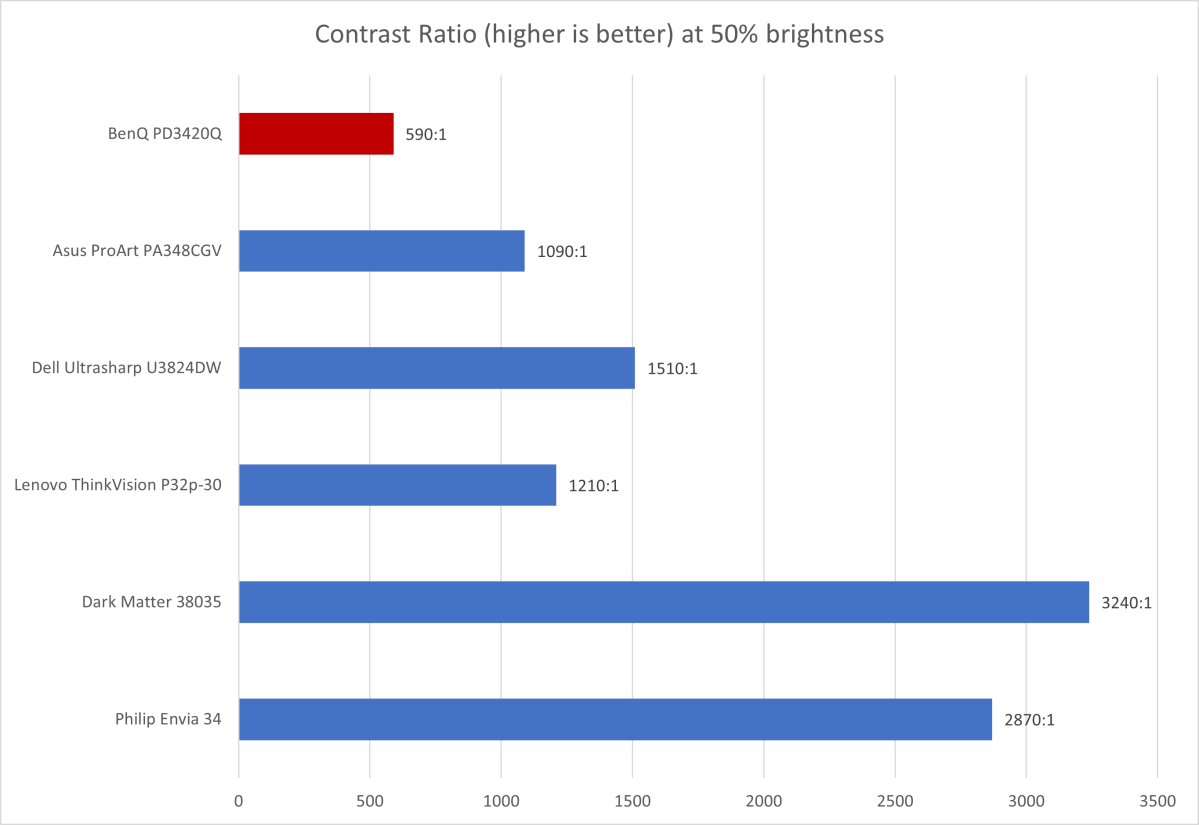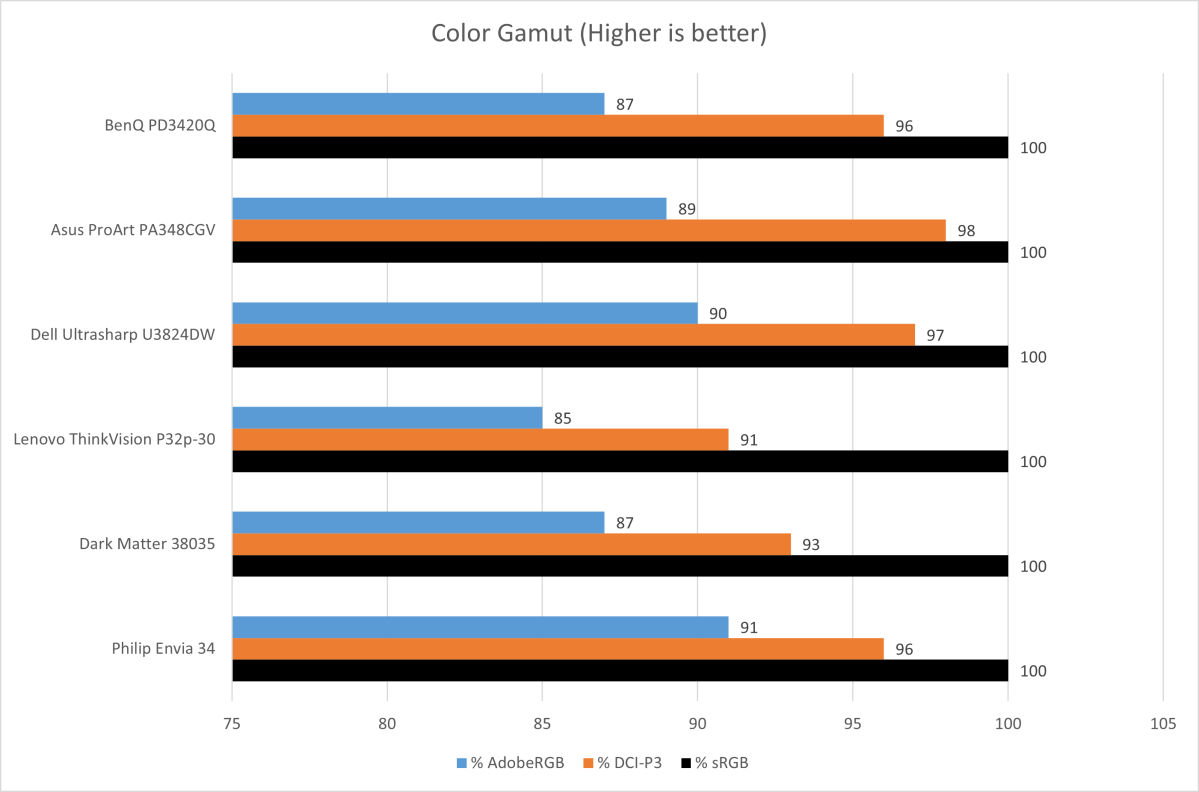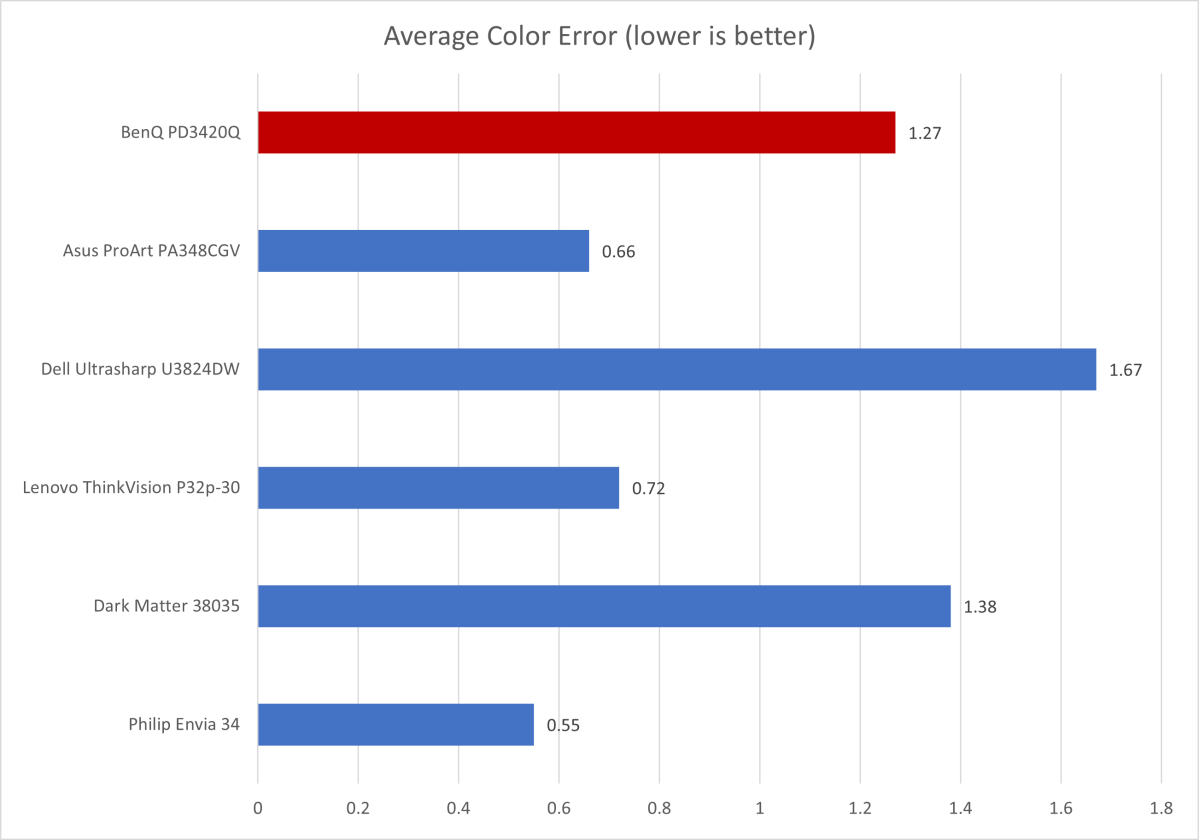Expert’s Rating
Pros
- Attractive, though subtle, design
- Good range of connectivity
- Easy-to-use menus
- Accurate image with multiple color modes
Cons
- USB-C only supports 65 watts Power Delivery
- Low contrast ratio
- HDR is supported, but lackluster
- 60Hz refresh rate
Our Verdict
BenQ PD3420Q is a solid ultrawide for creative pros, but its lack of versatility narrows its appeal.
Price When Reviewed
$699.99
Best Prices Today: BenQ PD3420Q
$699.99
Ultrawide monitors aren’t hard to come by in 2024, but most models still target games and entertainment over productivity and content creation, and most are curved. BenQ PD3420Q offers an alternative with a flat 34-inch panel and a focus on color accuracy, though shortcomings in the monitor’s contrast ratio, HDR performance, and refresh rate hold it back.
Further reading: See our roundup of the best ultrawide monitors to learn about competing products.
BenQ PD3420Q specs and features
The BenQ PD3420Q’s specifications could hardly be less interesting at a glance. Nearly all monitors of this size stick to 3440×1440 resolution, and most competitors also use an IPS panel. The monitor’s $699.99 MSRP is typical, too.
- Display size: 34-inch widescreen
- Native resolution: 3440×1440
- Panel type: In-Plane Switching (IPS)
- Refresh rate: 60Hz
- Adaptive sync: No
- HDR: Yes, VESA DisplayHDR 400 certified
- Ports: 2x HDMI, 1x DisplayPort, 1x USB-C with 65 watts Power Delivery and DisplayPort Alternate Mode, 3x USB-A downstream, 1x USB-B upstream, 3.5mm audio
- VESA mount: 100x100mm
- Speakers: 2x 2.5-watt stereo speakers
- Price: $699.99 MSRP
The monitor’s most notable features aren’t things listed in a display’s specifications. It has software available to adjust monitor features, a wired puck for accessing the on-screen menus, and significant image quality customization. These are useful for the monitor’s target audience, though they won’t move the needle for everyone else.
BenQ PD3420Q design
The BenQ PD3420Q is part of the company’s Designer Monitor sub-brand, which is tailored for creative professionals. And though it functions perfectly with a PC, it’s also prominently advertised as Mac-compatible.
That emphasis is reflected in its elegant yet understated design. The monitor offers an immersive viewing experience with slim bezels on three sides and a small bottom chin that lacks BenQ branding. It also adopts a dark charcoal color scheme, which might seem generic but suits its target audience well. The back continues the theme with an expanse of black plastic accented only by a discreet BenQ logo that’s easy to miss.
While the design is largely unremarkable, there’s a couple subtle traits worth notice. The monitor is completely flat, which is rare for a 34-inch ultrawide display. A curve, though more immersive in entertainment, can also skew the appearance of photos, digital art, video, and other content a creative professional might work on. I appreciate this, as I personally prefer a flat display over a curved display, with the exception of super-ultrawide aspect ratios.
The included ergonomic stand is excellent. It adjusts for height, swivel, and tilt, and offers a broader range of adjustment than most, with 60 degrees of swivel adjustment and 150 millimeters of height adjustment. The base of the stand is a bit broad but extremely flat, which ensures the space occupied by the stand remains usable desk real estate.
Switching the stand for a third-party monitor arm is relatively simple, as well. The PD3420Q has a 100x100mm VESA mount and weighs just 9.6 pounds, so most quality monitor arms will prove sturdy enough to handle it.
The included ergonomic stand is excellent. It adjusts for height, swivel, and tilt, and offers a broader range of adjustment than most.
BenQ PD3420Q connectivity and menus
The monitor’s focus on Mac compatibility means the BenQ PD3420Q includes a USB-C port with 65 watts of power delivery and DisplayPort Alternate Mode. It’s great for connecting most mid-range laptops like an Apple MacBook Pro 14 or a Dell XPS 14. Still, I would’ve preferred if BenQ included 90 watts of power delivery, or even a bit more, as many laptops used by creative professionals will require more power than the monitor’s USB-C port can provide.
Additional USB connectivity includes three USB 3.1 downstream ports and another USB-C port. The USB data ports can be accessed via USB-C, of course, but also through USB Type-B, a common choice for connecting a PC desktop. Video connectivity includes two HDMI ports and one DisplayPort 1.4, totaling four video connections when including the USB-C port. One USB-A port, one USB-C port, and the 3.5mm audio jack are placed on the monitor’s left flank, which makes them easier to use.
While the PD3420Q’s connectivity is solid, it doesn’t leap out from the crowd. Competitors like the Dell U3423WE deliver more power and add Ethernet for a similar price. However, what is provided here is sufficient for many creative professionals.
While the monitor’s connectivity is average, its other features are more notable. BenQ provides several Picture-in-Picture and Picture-by-Picture modes, a “Dualview” mode that can apply a color preset to only half the display for side-by-side comparisons, a KVM switch, one-click color calibration with Mac laptops, and a software utility called BenQ Display Pilot 2, which allows for control of some monitor features within Windows or macOS. There’s a clear focus on professionals who want to switch between different input devices throughout the day.
BenQ’s wired puck controller, which is used to navigate the on-screen menus, makes a return. The puck is easier and more convenient to use than the joystick and buttons located on the monitor itself, though they remain available. The monitor includes numerous color modes designed to target specific color gamuts and a wide array of color customization options.
The monitor also packs a pair of 2.5W speakers that provide adequate sound quality for basic tasks like operating system navigation or listening to podcasts. They’re meager at maximum volume and can sound muddy at times, however, so they’re not great for playing a game or watching a movie.
BenQ PD3420Q SDR image quality
Image quality is obviously key for BenQ’s target audience. Unfortunately, the PD3420Q struggles to make a positive impression.
Matthew Smith / Foundry
Our first test, brightness, demonstrates why the test remains relevant despite the high brightness of many modern displays. The PD3420Q’s maximum SDR brightness of 229 remains high enough that it should work in most situations, but it may appear dim in a bright, sunlit room. The monitor’s anti-glare coat does help to minimize the effect of the monitor’s modest brightness, but I still at times felt it could benefit from a few extra nits.

Matthew Smith / Foundry
Contrast, however, is where the BenQ PD3420Q runs into trouble. It reached a contrast ratio of just 590:1, which is much less than most competitive monitors. The low contrast ratio is mostly due to elevated black levels which create a hazy, gray look in darker content. It’s not as noticeable in a bright room, but very noticeable in a dark room, and leads to a flat, dull, washed-out look.

Matthew Smith / Foundry
The BenQ PD3420Q’s color gamut is respectable and by default spans 100 percent of sRGB, 96 percent of DCI-P3, and 87 percent of AdobeRGB. As mentioned earlier, the monitor offers many color modes that target particular color gamuts. These modes will slightly change the color performance and may even restrict the color gamut, when necessary.
With that said, the PD3420Q’s color gamut performance is in line with the competition. Some, like the Asus ProArt PA348CGV, perform a bit better. Others, like the Dark Matter 38035, are a tad worse. The difference either way shouldn’t make-or-break your decision unless color gamut performance is the top priority (which won’t be true for most people).

Matthew Smith / Foundry
It’s a similar story in color accuracy, where the BenQ PD3420Q achieved a solid but modest default color error of 1.27. That’s not the lowest we’ve recorded, but it’s respectable, and the monitor’s color customization options give owners the opportunity to tune the color to their needs. That will prove easier on the PD3420Q than with most competitors, including strong alternatives like the Asus ProArt PA348CGV.
The monitor did well in gamma, scoring a default gamma curve of 2.2, which is precisely our preference. However, the monitor’s gamma is adjustable to target a different gamma curve, if required. The color temperature was close to ideal, too, with a default color temperature of 6400K. That’s just a tad warmer than our target of 6500K, but the difference is hard to notice.
Sharpness continues the monitor’s streak of solid but unexceptional results, as the monitor has a resolution of 3440×1440, which works out to 109 pixels per inch. That’s by far the most popular resolution for a 34-inch ultrawide monitor. It’s sharp enough for most situations, but a 27-inch 4K monitor will of course look sharper.
The BenQ PD3420Q’s overall SDR image quality performance is specific to the monitor’s intended use. It’s not meant for entertainment, and while it can be used for coding or video editing, it’s best suited for photo editing and digital art. Contrast is often less important for these purposes than color accuracy and customization. With that said, I’m skeptical that the monitor’s sacrifices are worth the advantages. Competitors like the Asus ProArt PA348CGV can offer much better contrast and higher brightness at a similar price.
BenQ PD3420Q HDR image quality
The BenQ PD3420Q supports HDR and is VESA DisplayHDR 400 certified, but I wouldn’t recommend it for viewing HDR content. The monitor’s maximum brightness increased to 330 nits in HDR, which still isn’t enough to deliver significant additional detail. The contrast ratio also holds the monitor back as bright areas of the display cause an increase in brightness of dark areas of the display. That, in turn, restricts the monitor’s contrast.
It’s not all bad news, though. While HDR performance isn’t great, the monitor does a reasonable job of displaying SDR content alongside HDR. The color temperature, gamma, and color accuracy of SDR content remains acceptable in this situation, which isn’t true of all competing monitors. That’s good news if you want to view HDR content in a window on a desktop otherwise filled with SDR content and apps.
BenQ PD3420Q motion performance
Gaming isn’t a priority for the BenQ PD3420Q, and that comes across in its motion performance. The monitor has a maximum refresh rate of 60Hz and quotes a gray-to-gray pixel response time of five milliseconds. Neither is impressive.
As a result, motion clarity is mediocre at best. Fast-moving objects reveal enough detail to make out their silhouette, but fine details are obscured. Fast moving text and cursor-sized objects become illegible. The monitor also lacks Adaptive Sync, so frame pacing and screen tearing can be an issue when V-Sync is not engaged.
None of this is surprising given the PD3420Q’s audience. However, competitive monitors like the Asus ProArt PA348CGV, as well as the latest Dell Ultrasharp models, can hit up to 120Hz. That puts BenQ’s ultrawide a tad behind the leaders.
Should you buy the BenQ PD3420Q?
The BenQ PD3420Q tries to play it safe. It targets creative professionals with extensive color customization, a puck controller for easy menu access, and solid USB-C connectivity. But the PD3420Q never tries to do more than what’s necessary for that audience, to its detriment.
It’s a sensible pick for professionals who only work with tasks that demand exacting color accuracy and need to ensure the display fits a particular color profile. However, it’s not great for movies or games, and while it might handle video editing, that’s only true if you don’t work in 4K or HDR.
That makes the PD3420Q a niche pick. It’s a solid choice for productivity, photography, or digital art, but faces more versatile competitors that competently handle a wider range of tasks for the same price.



